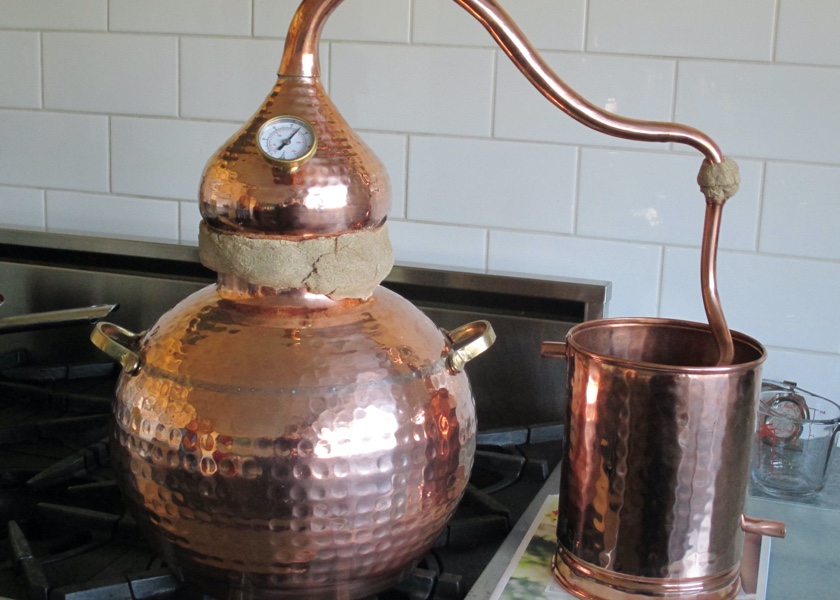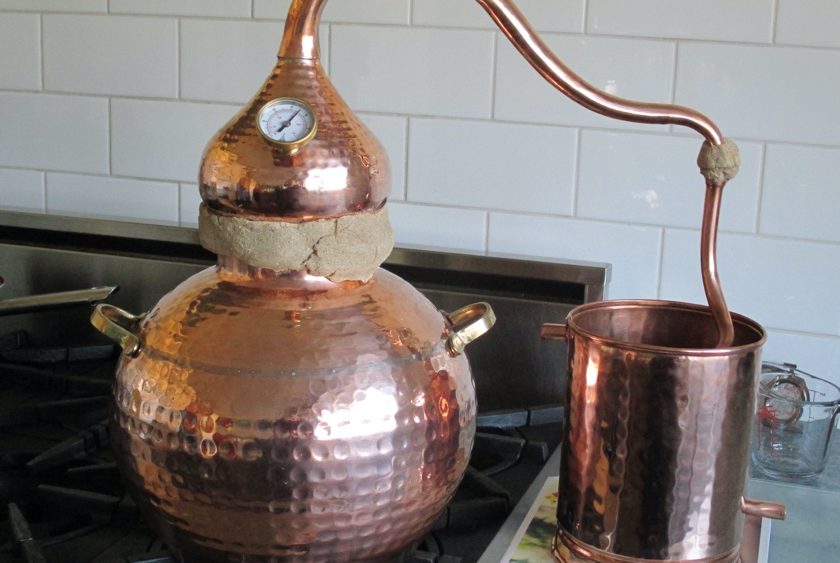
Spring is always about new beginnings, of fresh starts and new directions. What better way for a medical herbalist to celebrate a new season than by learning how to run a still? Not, I hasten to add, for the purpose of making moonshine but, rather to make hydrosols, the watery phase of essential oil distillation. These are like essential oils, but extremely dilute and can be used in perfumery, cosmetics and aesthetics, even in the kitchen. Having recently purchased a beautiful 10 litre, hand-hammered, copper still from Portugal, I have been very excited waiting for the right moment to try it out. That moment came during this past spring’s equinox.
First, we had to figure out how to position it safely on the stove top to heat the water, while having the outlet of the condenser coil positioned to drip into a collecting vessel. Once that was achieved, we put about four liters of water into the bottom half of the vessel, positioned the top half with the ‘swan neck’ going to the condensing coil. Then sealed the joints with a dough made of rye flour. I am not sure why the instructions call for Rye in particular, something to look into when I have time.
We then ran the still until most of the water had evaporated through, at which point it was deemed not just clean but tempered. After emptying out the remaining water, we refilled it with five liters of fresh water and 150 grams of freshly picked sage leaves. We chose sage because that was one of the few leafy things we had picked fresh from the garden. The leaves sat on top of the copper rack inside, in the water but above the metal bottom that was in direct contact with the heat source. You don’t want your herbs to scorch.
It took a few minutes before anything happened. We could see the thermometer on the chimneypiece rising, there was ice in the copper vessel around the condensing coil and finally, there was a steady dripping from the end of the coil. The smell was sweet and green and fresh, and really quite lovely, even though the leaves had been a bit faded and tattered at the end of the winter. It smelled of sage, faint but true, maybe even like ‘water of sage,’ which would of course be the literal translation of ‘sage hydrosol.’
You could imagine this being used in a facial product, maybe a toner or spritzer, for hot and bothered skin– red, irritated or inflamed. I could also imagine it in a refreshing room spray, clean and crisp, but still dark and perhaps slightly mysterious. If you are someone who is into novel cuisine, then hydrosol of sage could be a top note in sauces, dressings or marinades, the background to a sorbet to be served as a palate cleanser between meals, or could add an interesting depth to a chilled summer soup.
Of course, sage is just one of the many plants that we intend to try distilling this season. Many, maybe most, plants contain some volatile oils, some plants more than others. Violet, lavender, beebalm, peppermint, lemon balm, oregano, fennel, rose and rosemary and many more are well known as aromatic culinary or perfumery herbs that get their effect from volatile oils. Even the majestic evergreens, the cedar and fir and spruce, yield a hydrosol when their fresh green spring needles are distilled.
We are curious about distilling grass, stinging nettle or maple blossom. What about the tansy or yarrow that is so prevalent on our land? These are already known in herbal medicine or aromatherapy uses, but the hydrosols are less common and we are excited to be exploring this new/old frontier of phytotherapy.
We will keep you posted with our progress as we learn how to best use the still and which plants we like best.
Jul
14
